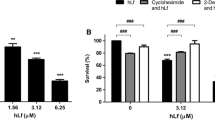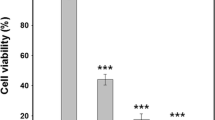Abstract
Clotrimazole is an antifungal medication commonly used in the treatment of fungal infections. There is also promising research on using clotrimazole against other diseases such as malaria, beriberi, tineapedis and cancer. It was aimed to investigate the apoptotic phenotype in Saccharomyces cerevisiae induced by clotrimazole. The exposure of S. cerevisiae to 10 µM clotrimazole for 3, 6 and 9 h caused to decrease in cell viability by 24.82 ± 0.81, 56.00 ± 1.54 and 77.59 ± 0.53%, respectively. It was shown by Annexin V–PI assay that 110 µM clotrimazole treatment caused to death by 35.5 ± 2.48% apoptotic and only 13.1 ± 0.08% necrotic pathway within 30 min. The occurrence of DNA strand breaks and condensation could be visualised by the TUNEL and DAPI stainings, respectively. Yeast caspase activity was induced 12.34 ± 0.71-fold after 110 µM clotrimazole treatment for 30 min compared to the control. The dependency of clotrimazole-induced apoptosis to caspase was also shown using Δyca1 mutant.







Similar content being viewed by others
References
Abe F, Usui K, Hiraki T (2009) Fluconazole modulates membrane rigidity, heterogeneity, and water penetration into the plasma membrane in Saccharomyces cerevisiae. Biochemistry 48:8494–8504
Adinolfi B, Carpi S, Romanini A, Da Pozzo E, Castagna M, Costa B, Nieri P (2015) Analysis of the antitumor activity of clotrimazole on A375 human melanoma cells. Anticancer Res 35:3781–3786
Bråkenhielm E, Veitonmäki N, Cao R, Kihara S, Matsuzawa Y, Zhivotovsky B, Cao Y (2004) Adiponectin-induced antiangiogenesis and antitumor activity involve caspase-mediated endothelial cell apoptosis. Proc Natl Acad Sci USA 101:2476–2481
Cerbón J, Calderón V (1991) Changes of the compositional asymmetry of phospholipids associated to the increment in the membrane surface potential. Biochim Biophys Acta Biomembr 1067:139–144
Chowdhury I, Tharakan B, Bhat G (2006) Current concepts in apoptosis: the physiological suicide program revisited. Cell Mol Biol Lett 11:506–525
Clausen CA, Yang VW (2005) Azole-based antimycotic agents inhibit mold on unseasoned pine. Int Biodeterior Biodegradation 55:99–102
Coelho RG, de Castro Calaça I, de Moura Celestrini D, Correia AH, Costa MASM, Sola-Penna M (2011) Clotrimazole disrupts glycolysis in human breast cancer without affecting non-tumoral tissues. Mol Genet Metab 103:394–398
Crowley PD, Gallagher HC (2014) Clotrimazole as a pharmaceutical: past, present and future. J Appl Microbiol 117:611–617
Cummings BS, Schnellmann RG (2002) Cisplatin-induced renal cell apoptosis: caspase 3-dependent and-independent pathways. J Pharmacol Exp Ther 302:8–17
Du L, Yu Y, Chen J, Liu Y, Xia Y, Chen Q, Liu X (2007) Arsenic induces caspase-and mitochondria-mediated apoptosis in Saccharomyces cerevisiae. FEMS Yeast Res 7:860–865
Duprez L, Wirawan E, Berghe TV, Vandenabeele P (2009) Major cell death pathways at a glance. Microbes Infect 11:1050–1062
Eisler H, Fröhlich KU, Heidenreich E (2004) Starvation for an essential amino acid induces apoptosis and oxidative stress in yeast. Exp Cell Res 300:345–353
Fernández-Torres B, Vázquez-Veiga H, Llovo X, JrM Pereiro, Guarro J (2000) In vitro susceptibility to itraconazole, clotrimazole, ketoconazole and terbinafine of 100 isolates of Trichophyton rubrum. Chemotherapy 46:390–394
Fröhlich KU, Fussi H, Ruckenstuhl C (2007) Yeast apoptosis—from genes to pathways. Semin Cancer Biol 17:112–121
Fulda S, Galluzzi L, Kroemer G (2010) Targeting mitochondria for cancer therapy. Nat Rev Drug Discov 9:447–464
Furtado CM, Marcondes MC, Sola-Penna M, De Souza ML, Zancan P (2012) Clotrimazole preferentially inhibits human breast cancer cell proliferation, viability and glycolysis. PLoS One 7:e30462
Furtado CM, Marcondes MC, Carvalho RS, Sola-Penna M, Zancan P (2015) Phosphatidylinositol-3-kinase as a putative target for anticancer action of clotrimazole. Int J Biochem Cell Biol 62:132–141
Gottlieb RA (2000) Mitochondria: execution central. FEBS Lett 482:6–12
Gourlay CW, Carpp LN, Timpson P, Winder SJ, Ayscough KR (2004) A role for the actin cytoskeleton in cell death and aging in yeast. J Cell Biol 164:803–809
Guillou S, Besnard V, El Murr N, Federighi M (2003) Viability of Saccharomyces cerevisiae cells exposed to low-amperage electrolysis as assessed by staining procedure and ATP content. Int J Food Microbiol 88:85–89
Hegemann L, Toso SM, Lahijani KL, Webster GF, Uitto J (1993) Direct interaction of antifungal azole-derivatives with calmodulin: a possible mechanism for their therapeutic activity. J Invest Dermatol 100:343–346
Herker E, Jungwirth H, Lehmann KA, Maldener C, Fröhlich KU, Wissing S, Madeo F (2004) Chronological aging leads to apoptosis in yeast. J Cell Biol 164:501–507
Hitchcock CA, Dickinson K, Brown SB, Evans EGV, Adams DJ (1990) Interaction of azole antifungal antibiotics with cytochrome P-450-dependent 14α-sterol demethylase purified from Candida albicans. Biochem J 266:475–480
Horng CT, Chiang NN, Chen IL, Liang WZ, Chen IS, Kuo DH, Jan CR (2013) Effect of clotrimazole on cytosolic Ca2+ rise and viability in HA59T human hepatoma cells. J Recept Signal Transduct Res 33:89–95
Hotchkiss RS, Strasser A, McDunn JE, Swanson PE (2009) Cell death. N Engl J Med 361:1570–1583
Iannelli A, de Sousa G, Zucchini N, Saint-Paul MC, Gugenheim J, Rahmani R (2011) Anti-apoptotic pro-survival effect of clotrimazole in a normothermic ischemia reperfusion injury animal model. J Surg Res 171:101–107
Ito C, Tecchio C, Coustan-Smith E, Suzuki T, Behm FG, Raimondi SC, Campana D (2002) The antifungal antibiotic clotrimazole alters calcium homeostasis of leukemic lymphoblasts and induces apoptosis. Leukemia 16:1344–1352
Jackson CJ, Lamb DC, Kelly DE, Kelly SL (2000) Bactericidal and inhibitory effects of azole antifungal compounds on Mycobacterium smegmatis. FEMS Microbiol Let 192:159–162
Jilani K, Lang F (2013) Carmustine-induced phosphatidylserine translocation in the erythrocyte membrane. Toxins 5:703–716
Liu H, Li Y, Raisch KP (2010) Clotrimazole induces a late G1 cell cycle arrest and sensitizes glioblastoma cells to radiation in vitro. Anticancer Drugs 21:841
Ludovico P, Rodrigues F, Almeida A, Silva MT, Barrientos A, Côrte-Real M (2002) Cytochrome c release and mitochondria involvement in programmed cell death induced by acetic acid in Saccharomyces cerevisiae. Mol Biol Cell 13:2598–2606
Mac Neil S, Wagner M, Kirkham PR, Blankson EA, Lennard MS, Goodall T, Rennie IG (1993) Inhibition of melanoma cell/matrix interaction by tamoxifen. Melanoma Res 3:67–74
Madeo F, Fröhlich E, Fröhlich KU (1997) A yeast mutant showing diagnostic markers of early and late apoptosis. J Cell Biol 139:729–734
Madeo F, Fröhlich E, Ligr M, Grey M, Sigrist SJ, Wolf DH, Fröhlich KU (1999) Oxygen stress: a regulator of apoptosis in yeast. J Cell Biol 145:757–767
Madeo F, Herker E, Maldener C, Wissing S, Lächelt S, Herlan M, Fröhlich KU (2002) A caspase-related protease regulates apoptosis in yeast. Mol Cell 9:911–917
Madeo F, Herker E, Wissing S, Jungwirth H, Eisenberg T, Fröhlich KU (2004) Apoptosis in yeast. Curr Opin Microbiol 7:655–660
Marcondes MC, Fernandes AC, JrI Itabaiana, de Souza RO, Sola-Penna M, Zancan P (2015) Nanomicellar formulation of clotrimazole improves its antitumor action toward human breast cancer cells. PLoS One 10:e0130555
Martin S, Reutelingsperger CP, McGahon AJ, Rader JA, Van Schie RC, LaFace DM, Green DR (1995) Early redistribution of plasma membrane phosphatidylserine is a general feature of apoptosis regardless of the initiating stimulus: inhibition by overexpression of Bcl-2 and Abl. J Exp Med 182:1545–1556
Mathur A, Hong Y, Kemp BK, Barrientos AA, Erusalimsky JD (2000) Evaluation of fluorescent dyes for the detection of mitochondrial membrane potential changes in cultured cardiomyocytes. Cardiovasc Res 46:126–138
Mazzoni C, Falcone C (2008) Caspase-dependent apoptosis in yeast. Biochim Biophys Acta Mol Cell Res 1783:1320–1327
Meira DD, Marinho-Carvalho MM, Teixeira CA, Veiga VF, Da Poian AT, Holandino C, Sola-Penna M (2005) Clotrimazole decreases human breast cancer cells viability through alterations in cytoskeleton-associated glycolytic enzymes. Mol Genet Metab 84:354–362
Mhawech-Fauceglia P, Wang D, Kesterson J, Beck A, de Mesy Bentley KL, Shroff S, Odunsi K (2011) Aldolase mRNA expression in endometrial cancer and the role of clotrimazole in endometrial cancer cell viability and morphology. Histopathol 59:1015–1018
Millard PJ, Roth BL, Thi HP, Yue ST, Haugland RP (1997) Development of the FUN-1 family of fluorescent probes for vacuole labeling and viability testing of yeasts. Appl Environ Microb 63:2897–2905
Mitsui K, Nakagawa D, Nakamura M, Okamoto T, Tsurugi K (2005) Valproic acid induces apoptosis dependent of Yca1p at concentrations that mildly affect the proliferation of yeast. FEBS Lett 579:723–727
Nargund AM, Avery SV, Houghton JE (2008) Cadmium induces a heterogeneous and caspase-dependent apoptotic response in Saccharomyces cerevisiae. Apoptosis 13:811–821
Peano A, Beccati M, Chiavassa E, Pasquetti M (2012) Evaluation of the antifungal susceptibility of Malassezia pachydermatis to clotrimazole, miconazole and thiabendazole using a modified CLSI M27‐A3 microdilution method. Vet Dermatol 23:131-e29
Penso J, Beitner R (1998) Clotrimazole and bifonazole detach hexokinase from mitochondria of melanoma cells. Eur J Pharmacol 342:113–117
Penso J, Beitner R (2002) Detachment of glycolytic enzymes from cytoskeleton of Lewis lung carcinoma and colon adenocarcinoma cells induced by clotrimazole and its correlation to cell viability and morphology. Mol Genet Metab 76:181–188
Sawyer PR, Brogden RN, Pinder KM, Speight TM, Avery GS (1975) Clotrimazole: a review of its antifungal activity and therapeutic efficacy. Drugs 9:424–447
Steller H (1995) Mechanisms and genes of cellular suicide. Science 267:1445
Streiblova E (1988) Cytological methods. In: Campbell J, Buffers JM (eds) Yeast, a practical approach. IRL Press, Oxford, pp 9–49
Wächtler B, Wilson D, Hube B (2011) Candida albicans adhesion to and invasion and damage of vaginal epithelial cells: stage-specific inhibition by clotrimazole and bifonazole. Antimicrob Agents Chemother 55:4436–4439
Wang J, Jia L, Kuang Z, Wu T, Hong Y, Chen X, Cheng B (2014) The in vitro and in vivo antitumor effects of clotrimazole on oral squamous cell carcinoma. PLoS One 9:e98885
Wyllie AH (2010) “Where, O death, is thy sting?” A brief review of apoptosis biology. Mol Neurobiol 42:4–9
Zhang H, Gajate C, Mollinedo F (2007) Mitochondrial derived ROS in edelfosine induced apoptosis in yeasts and tumor cells. Acta Pharm Sinic 28:888–894
Zucchini N, de Sousa G, Bailly-Maitre B, Gugenheim J, Bars R, Lemaire G, Rahmani R (2005) Regulation of Bcl-2 and Bcl-xL anti-apoptotic protein expression by nuclear receptor PXR in primary cultures of human and rat hepatocytes. Biochim Biophys Acta (BBA) Mol Cell Res 1745:48–58
Acknowledgements
This study was supported by Grants from Scientific and Technological Research Council of Turkey (TUBİTAK) with 116Z315 numbered project.
Author information
Authors and Affiliations
Corresponding author
Additional information
Communicated by Erko Stackebrandt.
Rights and permissions
About this article
Cite this article
Kavakçıoğlu, B., Tarhan, L. Yeast caspase-dependent apoptosis in Saccharomyces cerevisiae BY4742 induced by antifungal and potential antitumor agent clotrimazole. Arch Microbiol 200, 97–106 (2018). https://doi.org/10.1007/s00203-017-1425-7
Received:
Revised:
Accepted:
Published:
Issue Date:
DOI: https://doi.org/10.1007/s00203-017-1425-7




